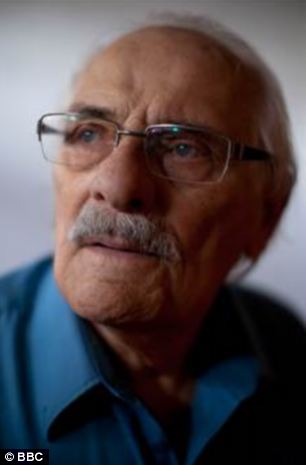
THINK-ISRAEL |

The last living survivors of Nazi death camp Treblinka have spoken about the excruciating torment they suffered during World War II.
Kalman Tagiman and Samuel Willenberg were both 19 years old when they arrived at the camp, where they were forced to assist in the mass murder of men, women and children.
For Samuel, now 89, it is one particular memory which haunts him to this day, 70 years later.
Samuel was sifting through the belongings of another trainload of doomed innocents, this time coming from his home town, when he made a discovery so horrific he fell to the floor.
A young girl's coat, and a pleated blue skirt, lying on top of a pile of clothes, just before the entrance to the gas chambers. The coat and skirt belonged to his two younger sisters.
The Treblinka 'death factory' was located in occupied Poland but was destroyed by the Nazis at the end of the war as they tried to cover their tracks.
Less than 70 Treblinka prisoners survived the war — they were a small part of the slave-labour prisoners who attacked guards and escaped the camp.
It is estimated that between 800.000 and 1.2million prisoners were taken to Treblinka. Prisoners arriving had only had one per cent chance of surviving the first three hours.
Due to the lack of physical evidence it is sometimes called 'the forgotten camp', and with only two survivors still alive to tell their stories it may soon be.
Which is why, despite his advancing age and unbearably painful memories, Samuel has vowed to spend his remaining years bearing witness to the terrible crimes committed there.
Speaking about the moment he realised his two sisters were among the latest victims, in a BBC documentary airing on Monday, Samuel, now living in Israel, remembers: 'It was the worst day of my life. Even now it makes me cry.'
'One morning a transport arrived. We ran in. There was a new system to remove clothes immediately, jackets, trousers, a production line. Suddenly I looked down. My sisters' clothes.
'I recognised Tamara's coat - it was too small for her so my mother had lengthened the sleeves with bright green material. And my other sister's skirt, navy with blue stripes... as if one was hugging the other. I immediately knew where they were, what had happened.'
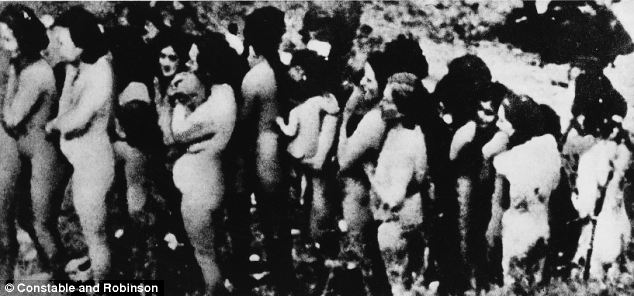
A minority of the prisoners were spared the chambers. Strong, young men were spared to assist their Nazi torturers at Treblinka which, at its peak, was killing 15,000 Jews a day.
Ten gas chambers worked simultaneously and the camp's commander Franz Stangl would proudly recall how he could 'process' an entire train between his breakfast at 7am and lunch at midday - an average of 6,000 Jews.
In fact, only 67 people are known to have survived the camp, fleeing in a brazen revolt in the summer of 1943 shortly before Treblinka was destroyed.
Kalman Taigman arrived at the camp with his mother after being rounded up along with thousands of other Jews in the Warsaw ghetto and transported to the camp hidden in the forests 60 miles northeast of Warsaw.
The only other living link to the 'forgotten' death camp, also now living in Israel, Kalman is also tormented by unimaginably painful memories of what went on there.
Remembering the day he arrived in July 1942, he says: 'I held tight onto mother's hand as we were herded out of the wagons. The Germans were hitting people, shooting people.
'They sent us to a place where there was an iron door. I came to the door with my mother together, but they said women to the left, and men to the right. I didn't want to let her go.
'Then I got something in my head from a German and I fell down. When I stood up I could see her being moved on, it was the last time I ever saw her. She was taken straight to the gas chambers.”
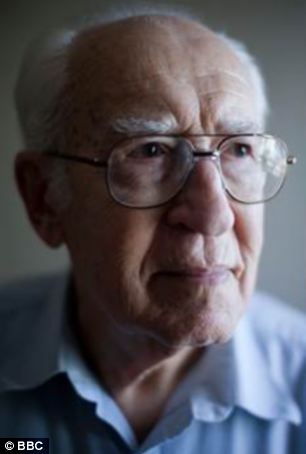 |
| Teenage memories: Kalman Taigman was 19 years old when he arrived at Treblinka |
Samuel, too, remembers being herded off the cattle cars at Treblinka in October 1942, and how a chance encounter saved him from being killed along with all the others.
'They stopped the train and the whole crowd got out. Suddenly I recognised a familar face. He asked, "Where are you from?" I answered, "Czestochowa". He said, "Tell them you're a bricklayer" and he disappeared.
'A second later an SS guard arrived. "Where is the bricklayer?" I pointed to myself. I got a kick in the bum and sent to the barracks. And then there was silence.'
The days of slavery at Treblinka were filled with never-ending horrors. When forced to sort victims belongings, the men often found newborn babies amongst the piles which the Nazis would take and burn alive in fire-filled pits.
Those too ill or weak to continue to the gas chambers, as well as injured and unaccompanied children, were taken into the so-called ‘Field Hospital' - a wooden building with a Red Cross flag flying outside. Once inside, they would be shot through the neck and thrown into mass graves.
Kalman recalls: 'It was hell, absolute hell. A normal man cannot imagine how a living person could have lived through it - killers, natural-born killers, who without a trace of remorse, just murdered every little thing.'
'There was death, just death,' says Samuel. 'God must have been on holiday. I looked for Him, but there was only beautiful Polish sky.'
Treblinka opened on July 23, 1942 and consisted of two camps - Treblinka I and Treblinka II.
Most of those who perished at the hands of the Nazis at Treblinka II were Jewish but there was also a minority of Romani.
Treblinka I was a forced labour camp, where more than 20,000 prisoners died from execution, exhaustion or maltreatment.
The camp was dismantled and a farmhouse was built in its place in an attempt to hide any evidence of genocide but the remotely located land is now a memorial.
Women were sent to the gas chambers after the men, so that their hair could be harvested and sold.
Samuel remembers a young woman from Warsaw who knew exactly what was about to happen.
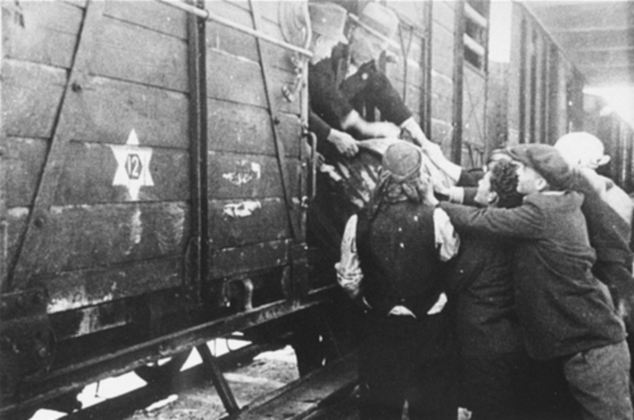
He remembers: 'She was about 19, maybe younger. I remember her name to this day. Ruth Dorfmann. I cut her hair, then she asked me how long it would last. I said ten minutes. She looked back and said farewell. She was really saying farewell to the whole world.
'Then we heard the sound of the tank engine, and that's how it ended.'
More humans were killed at Treblinka in 1942 than at any other place in the history of mankind.
By the end of the year, after 17,000 Jewish communities had been completely wiped out and almost all of Poland's Jews exterminated, the camp began taking in gypsies and over 135,000 Jews from across Europe.
One day, two SS officers were overheard making a toast in brandy, saying, 'We drink to the imminent arrival of the Jews of England!” referring to the 300,000 British Jews the Nazis believed would soon come under the control of the Third Reich.
But in February 1943 defeat to the Russians in the Battle of Stalingrad turned the tide of the war against the Germans.
Fearing that Nazi atrocities would one day be uncovered, Himmler ordered the destruction of all evidence of the Final Solution, including the cremation of over 750,000 corpses which had been buried at Treblinka.
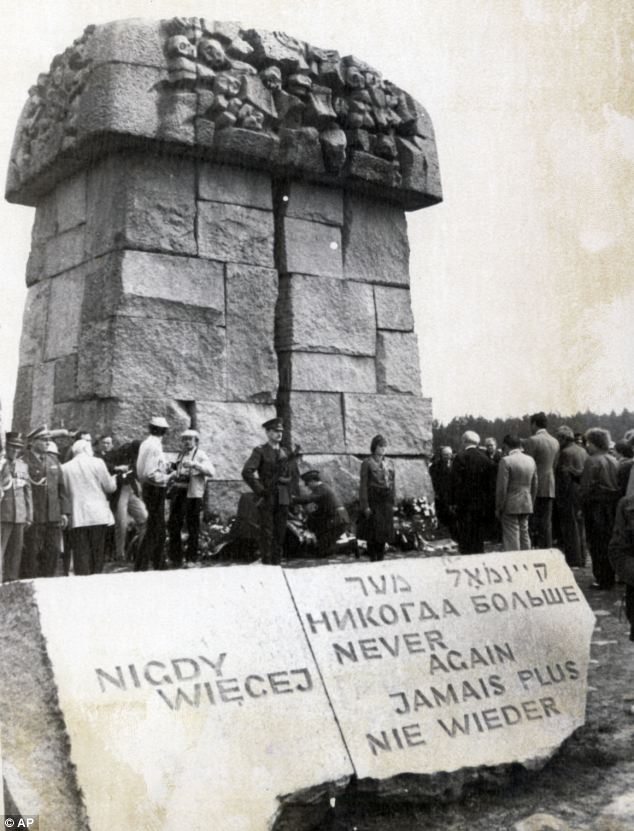
Again, Samuel and Kalman were among the Jewish slaves made to dig up and bodies and burn them - but this time they knew that once they had completed the grim work they too would all be killed.
So, on August 2, 1943, they were among 150 other Jewish prisoners who made a daring escape bid, stealing weapons, setting fire to the camp and fleeing into the woods during the night.
Most were shot and killed by SS troops in the surrounding mine fields or hunted down and killed by SS and Ukrainian military units.
Samuel was shot in the leg but kept on running, ignoring dead friends in his path. His blue eyes and non-Jewish features allowed him to survive in the countryside before making his way to Warsaw.
There he joined the Polish underground and fought against the Nazis in the 1944 Warsaw uprising.
Kalman, who ran in a different direction, remembers: 'After 15 minutes of running, we stopped, turned back and looked at how everything was burning, the flag with the swastika was on fire and falling down. Everything was burning. Our feeling was unbelievable. Me, outside? How?'
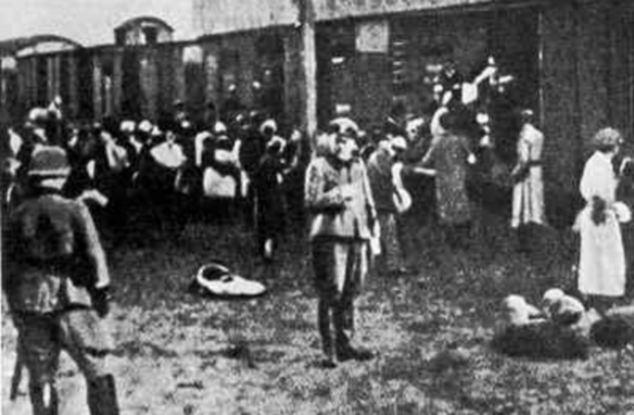
Kalman managed to avoid capture as he wandered for nearly a year in the Polish countryside after his escape.
After the war, Samuel and Kalman made their ways to Israel, where they pursued careers and raised families. Samuel became a surveyor in Israel's housing ministry and Kalman ran a successful import business.
In 1960 Kalman took part in the sensational trial of Adolf Eichmann, who Israel had dramatically kidnapped from his bolt hole in Argentina. As the world watch, he confronted the Holocaust architect from the witness stand with his first-hand accounts of Treblinka's untold atrocities.
Eichmann was convicted of crimes against the Jewish people and hanged in 1962.
Samuel, meanwhile, immortalised his memories in drawings and bronze sculptures, including one of Ruth Dorfmann, the young woman whose hair he shaved before her death.
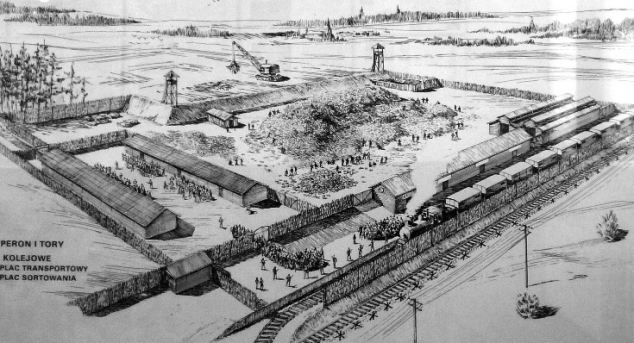
Even so, Holocaust deniers have used the lack of physical evidence, such as records or mass graves, to suggest there was no genocide at Treblinka and that it was just a transit camp for Jewish workers.
But those claims were scuppered earlier this year when British forensic archaeologist Caroline Sturdy Colls used ground-penetrating radar to find evidence of massive burial pits at the Treblinka site, which she said contains the burnt remains of thousands of bodies.
The last two survivors of Treblinka remain good friends, united both in their common experiences and in their desire to tell the world about the death camp's lost secrets before their voices, too, are forever silenced.
'I live two lives, one is here and now and the other is what happened there,' says Samuel. 'It never leaves me. It stays in my head. It goes with me always.'
'There are only the two of us left,' adds Kalman 'Soon there will be no-one left to tell. The world cannot forget Treblinka.'
Matt Roper is a writer for Daily Mail (UK). This article appeared August 15, 2012 in MailOnline http://www.dailymail.co.uk/news/article-2186984/Stories-Treblinka-Last-living-survivors-speak-horrors-haunting-memories-Nazi-death-camp.html#ixzz23MRMSBWR